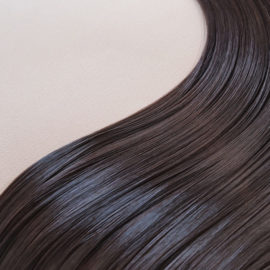The anagen phase of hair, represents a stage in which hair is actively created and extended. A more exhaustive knowledge about it has contributed to creating more informed consumers and, in a paradigm shift, brands are reacting by suggesting increasingly efficient science-based formulas for hair growth.
Hair loss is a common male grooming concern. This contributes to the prominence of products with anti-aging messaging, including anti-gray and anti-hair loss claims. Products like caffeine shampoos that claim to reduce hair loss are common, but there’s still room for growth in the market. Ultimately, this is because men want hair care supported by science; they want to see claims that target the biological causes of hair loss. Therefore, brands need to consider how to increase the anagen phase of hair through targeted treatments.
However, this isn’t to suggest that hair loss is a concern only for older male consumers. Younger men want to maintain their hair’s health and thickness, and equally, women are worried about hair loss. For instance, inSpain, 32% of women say that the benefit they find most appealing in a hair care product is that it promotes growth (Mintel, 2020). In light of this, brands need to create formulas that respond to diverse hair loss concerns, with added benefits.
Content
The biology of hair loss
The roots of our hair, or the follicles, go through a three-stage life cycle:
- It begins with a stage of rapid growth and hair shaft formation, known as the anagen phase.
- This is followed by a regression characterized by apoptosis or ‘cell death’.
- Finally, the follicle ‘rests’ in the telogen stage, before the process starts again. Generally, the percentage of follicles in the telogen phase ranges from 5 to 15%. An increase in this percentage leads to excessive hair loss or the appearance of thinning hair (Paus & Cotsarelis, 1999).
Hair thinning and permanent loss is caused by follicle miniaturization. This is when follicles that once produced healthy hair during their anagen phase begin to produce weaker, thinner strands. This process disrupts the growth cycle, making hair appear sparse. Ultimately, this can lead to fragile short strands and constricted follicles, which leads to permanent hair loss.

Meeting diverse hair loss concerns through formulas that target the anagen phase of hair
As inferred by this brief description of the hair life cycle, the question of how to increase the anagen phase of hair is a key concern for a wide range of consumers. For women, reducing the percentage of hairs in the telogen phase makes hair appear thicker and more luscious. Equally, a stimulated anagen phase can lead to greater hair growth. For men concerned about male pattern baldness, maintaining and stimulating said phase is key to delaying or preventing hair loss.
There’s also a growing awareness around hair health in general and scalp health in particular, as the scalp is seen more as an extension of facial skin. In the Korean market, elaborate skin care routines are extending to the scalp, with 15% of new hair care products in Korea featuring an anti-hair loss or scalp care claim – triple that of three years ago (Mintel, 2020). As scalp health is a concern for both men and women, such claims have far-reaching potential.
Clearly, with a scientific as opposed to age- or gender-oriented approach, brands can develop adaptable formulas. Creating products with more universal appeal can respond to consumer demands from multiple angles: right now, 64% of Generation Z consumers do not think that beauty or grooming products should be classified by gender (Lightspeed/Mintel, 2020).
Equally, added benefits like mood-boosting or de-stressing claims are attractive, especially in the context of a self-esteem related issue like hair loss. Currently, 46% of Chinese consumers say they are willing to pay more for products that contain ingredients that can help them to relax or sleep. Alongside the central question of how to increase the anagen phase of hair, relaxing or anti-stress scents are a key opportunity (Lightspeed/Mintel, 2020).
Provital’s research into how to increase the anagen phase of hair
Researchers at Provital asked themselves how to increase the anagen phase of hair, while taking into account how consumers are asking “how can I increase my slow hair growth?”, with a preference for natural products. Now, there are several ingredients in Provital’s portfolio that help increase slow hair growth by supporting the anagen phase. One example is Baicapil™. This active ingredient has the ability to extend the anagen period and shorten the telogen period, by improving the condition of the follicle cells and their microenvironment. A healthy scalp is essential to healthy hair, and with calming, soothing botanicals, this active nourishes the scalp’s delicate skin.
These powerful botanicals are Scutellaria baicalensis, Triticum vulgare, and Glycine max sprouts. These ingredients increase cellular energy and activate follicle stem cells while protecting them from senescence, or cell deterioration. This way, it visibly fights hair loss by improving the ratio of hairs in the anagen phase compared to the telogen phase, thus making hair appear fuller, thicker, and stronger. For users asking how to increase the anagen phase of hair naturally, there’s now a convincing answer: you can go further than dietary changes by using natural botanicals that minimize cell deterioration and activate follicle stem cells, such as Baicapil™. This active ingredient provides a natural alternative for hair health, setting new scientific findings at the heart of a growing natural cosmetics market.
Frequently asked questions about the anagen phase of hair
What supplements increase the anagen phase of hair?
If you’re looking for incorporating supplements that may increase the anagen phase of hair, it’s advisable they include the following components:
- Biotin, also known as vitamin B7 or vitamin H, as it’s involved in the production of keratin, the protein that makes up the structure of hair
- Zinc is known to be involved in hair growth processes
- Vitamin D, as it’s involved in the regulation of hair follicle cycling
- Fish oil, which contains omega-3 fatty acids that support a healthy scalp and promote hair growth
How do I know if my hair is in the anagen phase?
It’s not possible to detect the anagen phase in hair follicles without a microscopic look at the scalp. However, there are some clues that might indicate it is taking place:
- Constant hair growth
- Increased hair density, as the anagen phase implies a bigger quantity of follicles at a growth stage
- Strong, resistant hair that doesn’t fall as much when brushed
Why is my anagen phase short?
The duration of anagen phase of hair can range from 2 to 7 years on average. This duration is influenced by different factors for each individual, including:
- Genetics
- Hormonal imbalances or disorders
- Age, as hair growth cycles typically slow down with age
- Inadequate nutrition and a lack of certain nutrients such as iron, zinc or biotin, among others
- Certain medical conditions, such as autoimmune diseases
- Pollution
- UV radiation
- Harsh hair care routines
No comments yet
There are no comments on this post yet.






Leave a comment